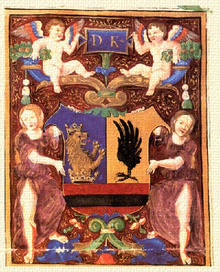Dorothea Kanizsai
Dorothea (ung. Dorottya) Kanizsai (* around 1475 in Kanizsa , † after 1532) was a Hungarian nobleman and benefactress.
Life
Dorothea Kanizsai is known as a benefactress of the Hungarian people and is highly revered all over the country.
She was the daughter of Miklós (Nikolaus) Kanizsai who was Obergespan de Komitates Oedenburg . Her first marriage was happily married to Peter Geréb. When he died in 1503, his widow had a chapel built over his grave in Walpach . At the same time she donated a large amount to the church with the stipulation that the deceased should regularly read soul masses. After the death of her first husband, she married Imre Perényi. This marriage was less fortunate as Perényi was a proud and powerful man. Dorothea, on the other hand, was a very modest woman and liked to live in seclusion. When Perényi died on February 5, 1519, Dorothea no longer married. She took care of the children of her second husband.
She was sociable and often stayed at the court of King Ludwig II of Hungary and also took part in his deliberations, which was quite unusual for a woman of the time. At her own request, Dorothea Kanizsai received a family coat of arms from King Ludwig II of Hungary, on which the Geréb and Kanizsai families are depicted. Dorothea is mentioned very flatteringly in the nobility letter.
On August 29, 1526 the battle of Mohács took place. This battle is described in Hungarian historiography as one of the greatest disasters in the history of Hungary. The Hungarian army, led by King Ludwig II and the Archbishop of Kalocsa Pál Tomori , was crushed by the Turks. Tomari fell in this battle and the king drowned in Bach Csele while fleeing. Around 24,000 soldiers of the Hungarian army were killed in the battle. In search of her stepson Ferenc Perényi after the battle, Dorothea Kanizsai visited the battlefield, which was littered with corpses. It is thanks to their charitable and philanthropic attitude that the bodies - with the help of their 400 serfs and the clergy of the surrounding area - were dignifiedly buried.
After Siklós Castle - which was owned by the Perényis - located on the southern slope of the Villány Mountains (in today's southern Hungary), came under Ottoman rule, Dorothea Kanizsai was forced to leave it. She moved to Sárvar Castle , the old Kanizsai family seat, which belonged to her late brother György Kanizsai († 1510). She took care of his children and descendants. The last written mention of Dorothea Kanizsai comes from 1532, on the occasion of a meeting of the Hungarian nobility. After that their trace disappears in the darkness of history; it is no longer mentioned in the literature after this point in time. Nothing is known about the date and place of her death.
Honors and posterity
Dorothea Kanizsai has not been forgotten in Hungary even today. She is known as one of the most charitable personalities in all of Hungarian history. Numerous schools, streets and squares were named after her. In Nagykanizsa , there is even a hospital ( Kanizsai Dorottya Kórház ) carries the her name. In Mohács there is a national memorial ( Mohácsi Nemzeti Emlékhely) with a museum, which not only commemorates the historical battle, but also Dorottya Kanizsai.
literature
- Terézia Hajós Baloghné: Mohács angyala ( Eng . "The Angel of Mohács"), life story of Dorothea Kanizsai, Athenaeum Budapest, undated (Hungarian)
- Sándor Takács: Kanizsai Dorothea in "Magyarország nagyasszonyok" Vol. 1, Budapest 1926 (Hungarian)
- Magyar Életrajzi Lexicon, Budapest 1981, vol. 1, p. 850, ISBN 963-05-2498-8 (Hungarian)
Web links
Individual evidence
- ↑ Two siblings of Dorothea Kanizsai are known: Georg (György) and Katharina (Katalin).
- ↑ Peter Geréb (* ~ 1447, † 1503) was a general who served under the kings Matthias Corvinus and Vladislav II . He held important posts in the Kingdom of Hungary: 1478-79 he was Banus of Transylvania, 1499 to 1503 Palatine of Hungary.
- ↑ Walpach ( Croat . Valpovo, Hungarian Valpó) was a small town on the Drava in Virovititz county . The town is now part of Croatia . The castle ruins that belonged to the Geréb family are also located in the village.
- ↑ Imre Perényi, also known as Emericus Perenius (* ~ 1459, † February 5, 1519) was a Palatinus of the Kingdom of Hungary . From his first marriage to Magdalena Báthory came the future bishop of Oradea Ferenc Perényi (* before 1500, † 29 August 1526), as well as Peter Perényi (* ~ 1502, † January 1548), the later crown guardian and voivode of Transylvania .
- ↑ The rule Sárvár belonged (with interruptions) from 1390 to the Kanizsai family. The last male lord of the castle was Lászlo (György's son and nephew of Dorothea) who died on September 21, 1525. His daughter Ursula Kanizsai married the Palatine Thomas Nádasdy as the last descendant of the Kanizsai family . As a result, the family property of the Kanizsais passed into the possession of the Nádasdys .
- ↑ As early as the 1960s, mass graves were found on the site of the battle . At that time, the idea of building a memorial at this point came up. The realization of the project began in 1975. And the memorial was opened on August 29, 1976, on the 450th anniversary of the battle, and opened to the public.
| personal data | |
|---|---|
| SURNAME | Kanizsai, Dorothea |
| ALTERNATIVE NAMES | Kanizsai, Dorottya |
| BRIEF DESCRIPTION | Hungarian nobleman and benefactress |
| DATE OF BIRTH | around 1475 |
| PLACE OF BIRTH | Kanizsa |
| DATE OF DEATH | after 1532 |



